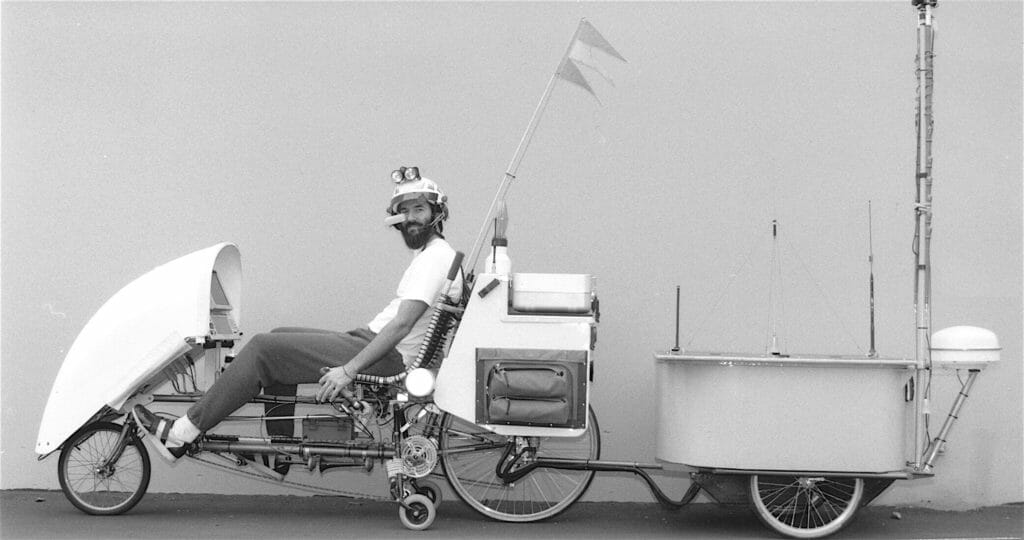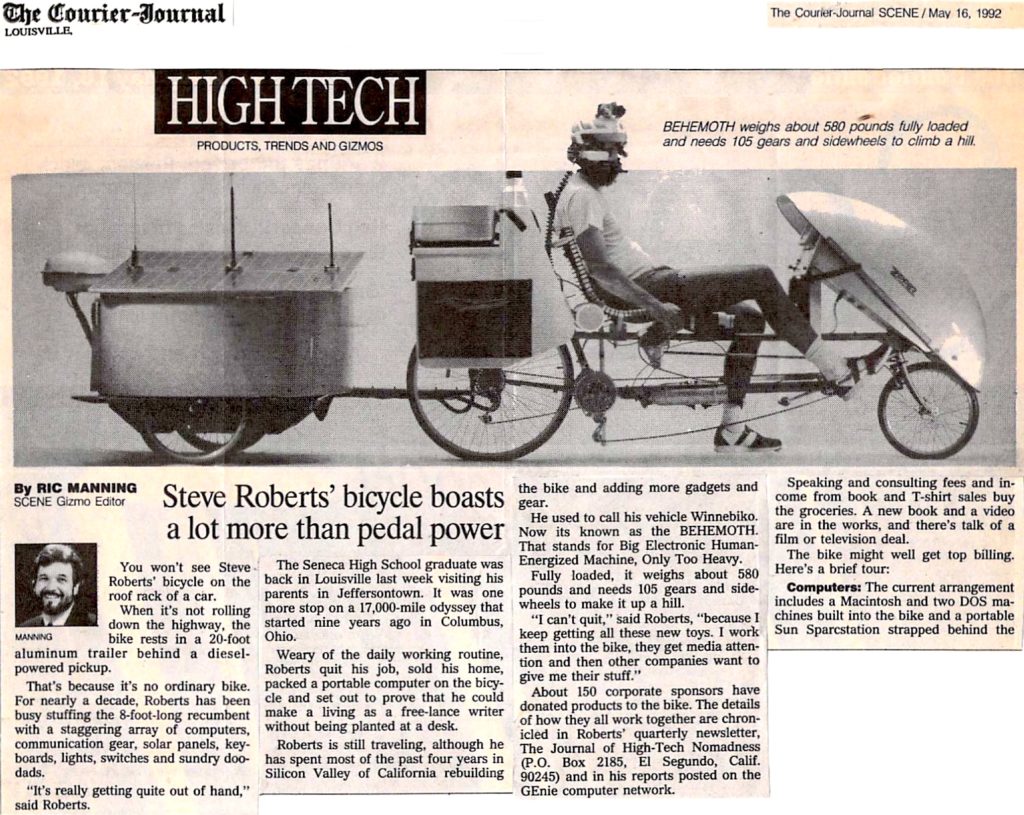
A Lot More than Pedal Power
BEHEMOTH weighs about 580 pounds fully loaded and needs 105 gears and sidewheels to climb a hill.
This delightful article in my old hometown newspaper came out during the peak of the BEHEMOTH epoch… I was no longer pedaling around the US, but the speaking/media tour via mothership was in full swing. The author, Ric Manning, did an excellent job of capturing the whole point of my adventure… as he had four years earlier when writing about the Winnebiko II.
by Ric Manning, Gizmo editor
Louisville Courier-Journal
May 16, 1992
You won’t see Steve Roberts’ bicycle on the roof rack of a car.
When it’s not rolling down the highway, the bike rests in a 20-foot aluminum trailer behind a diesel-powered pickup.
That’s because it’s no ordinary bike. For nearly a decade, Roberts has been busy stuffing the 8-foot-long recumbent with a staggering array of computers, communication gear, solar panels, keyboards, lights, switches and sundry doo-dads.
“It’s really getting quite out of hand,” said Roberts.

The Seneca High School graduate was back in Louisville last week visiting his parents in Jeffersontown. It was one more stop on a 17,000-mile odyssey that started nine years ago in Columbus, Ohio.
Weary of the daily working routine, Roberts quit his job, sold his home, packed a portable computer on the bicycle and set out to prove that he could make a living as a free-lance writer without being planted at a desk.
Roberts is still traveling, although he has spent most of the past four years in Silicon Valley of California rebuilding the bike and adding more gadgets and gear.
He used to call his vehicle Winnebiko. Now its known as the BEHEMOTH. That stands for Big Electronic Human-Energized Machine, Only Too Heavy.
Fully loaded, it weighs about 580 pounds and needs 105 gears and sidewheels to make it up a hill.
“I can’t quit,’ said Roberts, “because I keep getting all these new toys. I work them into the bike, they get media attention and then other companies want to give me their stuff.”
About 150 corporate sponsors have donated products to the bike. The details of how they all work together are chronicled in Roberts’ quarterly newsletter, The Journal of High-Tech Nomadness (old address redacted) and in his reports posted on the GEnie computer network.
Speaking and consulting fees and income from book and T-shirt sales buy the groceries. A new book and a video are in the works, and there’s talk of a film or television deal.
The bike might well get top billing. Here’s a brief tour:
Computers: The current arrangement includes a Macintosh and two DOS machines built into the bike and a portable Sun SPARCstation strapped behind the seat. Video displays for the Mac and the PCs are built into the front panel, and Roberts’ helmet has a tiny display called the Private Eye that swivels into place in front of his right eye.
The helmet also contains an ultrasonic device that moves the cursor on his computer screens when Roberts moves his head. And a set of keys built into the bike’s handlebars let Roberts type — or play a synthesized flute — while he pedals.
Communication: Roberts gets electronic mail through GEnie, MCI Mail and Internet networks. If he isn’t plugged into a phone line, dispatches can be routed to him by satellite. The bike’s speech synthesizer will announce when a new batch has arrived.
The bike also has a cellular phone receiver that Roberts can patch to an ordinary answering machine, fax machine and cordless telephone. BEHEMOTH’s trailer packs a ham station that covers 80 meters through UHF.
Navigation: A Global Positioning System takes readings off a satellite to tell the bike its latitude and longitude to within 50 feet, and a Sony CD-ROM
drive can put detailed street maps of every state on the main display screen.
Comfort: The bike’s 82 watts of solar panels power the electronics, but they also feed a Peltier refrigerator, which is linked by a fluid loop to a heat exchanger in Roberts’ helmet.
BEHEMOTH also has an AM/FM radio with a cassette and CD player connected to a Yamaha stereo amp and a pair of Blaupunkt speakers. Roberts can blend various audio channels in his helmet headphones to maintain radio contact while rocking and rolling.
Security: The bike has seven levels of security, enough to let Roberts leave it outside when he spends the night in a motel.
One sensor knows when someone gets within 10 feet of the bike. Another system delivers verbal warnings to anyone who touches the bike while beeping Roberts’ pocket pager. The bike can also dial 911 and deliver a synthesized call for help and broadcast an alert — complete with the bike’s location — on the ham bands.

All the hardware is starting to test Roberts Law of Applied Mobile Gizmology: An infinite number of very light things soon become infinitely heavy.
That’s why he’s driving to New York this week and not pedaling. He’s booked for appearances on “Donahue” and “Good Morning America.” After that, he’ll be in Washington, D.C., for a trade show and more interviews, including one with National Public Radio.
Eventually, Roberts says, he’ll get back on the road for another extended trip, probably through the Northwest later this summer. But first he wants to get the Sun workstation built into the bike.
Sure, he admits, the bike already has plenty of computing power.
“But I’ve always wanted to learn to ride a Unix cycle.”
NOTE: In a recursive footnote, Ric included this and his earlier article in his September 2020 piece, Catching Up with Digital Nomad Steve Roberts.


You must be logged in to post a comment.